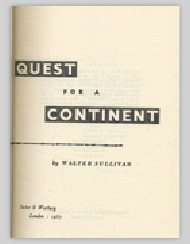S
SALE, Richard
To the Ends of the Earth: A History of Polar Exploration
This text provides an insight into the early history of the Polar regions, and tells the stories of Man' s first exploration of the Arctic and Antarctic, and subsequent expeditions. The history of individual Polar expeditions has been told many times, but usually only as personal accounts of individual adventures. This misses the overall context of polar exploration - why the British depended on ponies, or plant-eating animals (on the only continent where plants don' t grow), why Franklin' s men perished when the local Eskimos were eking out an existence around them (and reporting Franklin' s demise), and why the Scandinavians were always better than anybody else. The first map of Antarctica was produced in 1556 - the Vikings visited the Arctic 1,000 years before. In 2001, the US Base at the South Pole is manned 365 days a year. The book tells the whole story of how the two last wildernesses, at either end of the world, were discovered, conquered and tamed.
(Review from publishers material).
POLAR REACHES; THE HISTORY OF ARCTIC AND ANTARCTIC EXPLORATION
The USA/ Canada version (London: HarperCollins and Seattle: Mountaineers Books, 2002)
SAVOURS, Ann
The Voyages Of The Discovery: The Illustrated History of Scott's Ship.
Every last detail about this famous ship is here. The 'Discovery' was built for the 1901-04 expedition in Dundee, Scotland. This is where the ship now lies and is open to the public. The book rightly concentrates on its Antarctic voyages. Published 1992 the author has since reworked with additional photographs. This is published by Chatham in 2001.
Scott's Last Voyage
Pictorial and biographical book on Scott's official photographer. Published 1974 Sidgwick & Jackson.
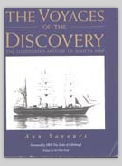
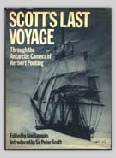
SCOTT, Robert Falcon
Scott's Voyage Of The 'Discovery'.
This book celebrates the start of the heroic age of Antarctic exploration. It is quite a thick volume and reflects Scott's ability at writing. Ernest Shackleton was a member of the expedition and due to an attack of scurvy was declared unfit and returned after only one winter in Antarctica. There is no doubt that there was a major clash between Shackleton and Scott but good manners and the need to say that everything was a success was paramount. It is what is not said that makes this book interesting.
It is amazing to think that this book is nearly 100 yrs old. It was first published in October 1905, reprinted by November 1905 (Smith Elder). There followed a steady stream of new editions and reprints mostly under John Murray. There was also mixture of books published in 1913/14 such as 'Voyages of the Terra Nova' and the popular 'The Voyages of Capt. Scott retold from the Voyages of Discovery and Scott's Last Expedition'. (Smith Elder 1914). The USA version was published by Dodd Meads.This book is not as common as 'Last Expedition' which of course was the more dramatic story. First editions fetch about £200.
Scott's Last Expedition: The Personal Journals of Captain R.F. Scott, CVO, RN.
A key source of primary evidence. It is of course, not perfect, and has been thoroughly edited. There is little personal opinion and it is a statement of facts and figures. It is however, the last will and testament of a great English explorer. Scott has the skill of writing (provided it was based on factual evidence - abstract thought probably drilled out of him in the Navy). The story is told in strict diary form and builds up to the now famous quote on finding that Amundsen had beaten him to the pole 'God this is an awful place'. Here the diary distinctly turns as the realisation dawns that the return journey is not going to be easy. There is a photograph taken at the pole of the team looking at the camera. Look at it and see in their faces the emotional drain. Would they have made it back, if they had been the first to the pole in the same circumstances? The tragic deaths of Evans and Oates hits the reader- Scott's true feelings now only coming to the fore. To the end he knows he has a role to play and believes the failure was partially down to bad luck and to a certain extent it was, years later it was proved that the weather was unusually severe. The limitation of science at that time especially in relation to diet was not entirely Scott's fault. The diary is a 'must read' but its for what is not in it, more than anything else.
The book has been extensively published and reprinted over the years. Smith Elder first published in two vols. in November 1913 and it was to say the least, eagerly bought by the public. A second and third edition also came in November of that year and two further editions by the end of January 1914. It was not until 1923 that John Murray issued a one vol. edition. This was also extensively reprinted. By 1954 it was on its 11th reprinting. The 12th printing onwards had a foreword by Peter Scott. The Folio Society issued a good edition in 1964 with a foreword by Sir Vivian Fuchs.
Editions in the last few years have played around with the title. This seems to be mainly for the American market- 'Tragedy and Triumph: The Journals of Captain RF Scott's Last Polar Expedition.' ( Published by Kowecky & Kowecky 1993) or 'Scott's Last Expedition. The Journals' (Carroll & Graf 1996).
Values- a 1913, 2 vol. copy fetches between £240 -£340. I have seen a first edition valued at £2,400 but this was perhaps because its was signed by the surviving expedition members!
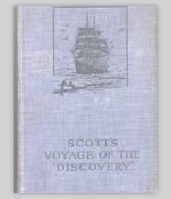
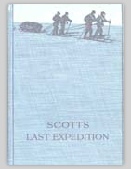
SCOTT, Jameds Maurice.
The Polar Regions: An Anthology of Artic and Antarctic Photographs.
A collection of photographs by the official exploration photographers includes Ponting and Hurley. Published 1937 by Chatto & Windus.
SCOTT, Peter.
The Eye of the Wind
Not a book about the Antarctic but early family recollections and photographs make this a worthwhile read. Early signed copies are worth looking out for. The book itself is a bit stifled (like his father's) but Peter still does more in his life- time than millions of others. Published June 1961 by Hodder & Stoughton.
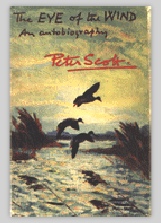
SEAVER, George.
'Birdie' Bowers of the Antarctic
Biography of Henry Robertson Bowers who was to die with Scott. This is a good good book about an unique man. Published by John Murray 1938.
Edward Wilson, Nature Lover.
Filled with excellent sketches. It shows the talents this man had and his gentlemanly manner comes across strongly in this book. Published by John Murray 1937
The Faith of Edward Wilson
Not about exploration but here because it forms part of a series of books by Seaver. Further evidence of Wilson's strong character. John Murray first published in 1948.
Scott of the Antarctic. A Study in Character.
A good, but a one-sided view of Scott. Issued with the full approval of the British Antarctic Expedition and Lady Scott. The official biography. Published by John Murray in 1940.
Edward Wilson of the Antarctic: Naturalist and Friend
This book is illustrated with Wilson's own sketches. It tells of a great Victorian character and gentleman. The biography is now rather dated and has not a hint of controversy or scandal. Wilson was one of Scott's special select group and was the 2nd doctor on the 'Discovery' expedition. Both of them saved the life of Shackleton. Wilson was to die along side Scott, a friend and loyal colleague to the very end. This book was very popular and ran into several editions and reprints. John Murray first published in October 1933
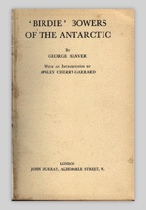
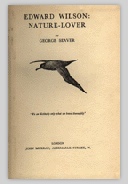
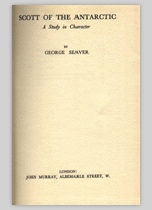
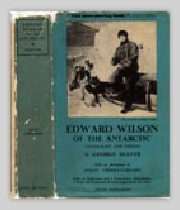
SELLICK, Douglas.
Antarctica: First Impressions 1773-1930
Edited By: Douglas R. G. Sellick
Fremantle Arts Centre Press (2001)
This review from the publishers web site:
These travellers' tales have one thing in common: they are true.
Antarctica is the driest, the windiest, the highest continent on earth. And the least known. This anthology offers a diverse collection of gripping autobiographical first impressions of travellers of all kinds to Antarctica. From the very famous, to the many long forgotten expeditions and voyagers, whose stories are some of the most extraordinary tales of courage and daring ever published.
Stories from:
James Cook
James Weddell
James Eights
Charles Wilkes
Sir James Clark Ross
William JJ Spry
Henrik Johan Bull
Frederick Albert Cook
Ernest Henry Shackleton
Roald Amundsen
Edward Evans
Herbert Ponting
Frank Debenham
Douglas Mawson
Ernest Joyce
Sir Hubert Wilkins
Introduction by: Professor Peter Spearritt Director of the National Centre for Australian Studies, Monash University.
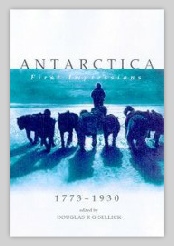
SHACKLETON, J & MACKENNA, J.
SHACKLETON: AN IRISHMAN IN ANTARCTICA
by Jonathan Shackleton and John MacKenna. (Dublin: The Lilliput Press, 2002)
Published in the US by University of Wisconsin Press, 2003.
SHACKLETON, Sir Ernest.
Heart of the Antarctic, Being the Story of the British Antarctic Expedition, 1907-1909.
Pub. 1909 by Heinmann. Shackleton's monumental account of his quest for the South Pole, where he turned back 97 miles short of his goal rather than press on and risk not having the food or time to make it back to base camp.
South: The Story Of Shackleton's Last Expedition 1914-1917
This is Shackleton's own account of the Endurance expedition. Setting out from Britain on the day war broke out in 1914 it sets the goal of the first transantarctic crossing. He never achieved this, Endurance stuck fast in the ice he wintered on board for 9 months. The shifting ice finally crushing the ship and the story begins. What a story it is, Shackleton took the crew across 600 miles of frozen and rapidly thawing ice to a remote barren outcrop called Elephant Island. He then with a crew of four crossed 850 miles of Southern Ocean, climbed a uncharted mountain range and successfully sought help from the whaling station at South Georgia Island. Shackleton rescued every one of his crew, its an astonishing story of courage and leadership .Within this book is the often forgotten tale of equal courage by the support party in the Aurora. They managed to leave supplies in the most appalling conditions for the expected transantarctic party - not knowing the fate that had befallen them.This is rightly an important book in this subject matter. Photographs are by Frank Hurley and are simply superb.
Print runs and new editions are numerous. The book was first published by Heinemann in 1919. These editions in two volumes fetch up to £500. Editions were later published by them in 1921, 1923, 1927 1932 and 1970. Later editions dropped the rather long title and left it as 'South'. Various other publishers issued special 'cheap edition' or 'popular' . Longman and Green(1938)/ Lyon Press (NY)(1998)/ Pimlico(1999)/ Robinson(1998)/ Penguin Putnam(1999).
Always try to obtain the Heinemann editions, later books were issued for the America market and are often edited to suit.
AURORA AUSTRALIS,
Shackleton had been a member of Scott’s expedition 1901—1904, and had edited the expedition’s paper The South Polar Times. This had been produced on a typewriter and with hand drawn images by Wilson. He saw the affect it had in helping maintain morale and this time Shackleton, provided the men of the Nimrod with the means to produce a book. The platten letterpress used was donated by Causton & Sons and include instruction in its use which was greatly received by Ernest Joyce and Frank Wild.
Taking its title from the ‘southern lights’ phenomenon, Aurora Australis is the first book created entirely in the Antarctic. Not just conceived, written and produced on a typewriter, but printed on a press, with the illustrations lithographed and etched, and bound on site as well.
The binder, Bernard Day, was the expedition’s motor mechanic. He used the Venesta board (a precursor of plywood) from the packing cases to make book covers. These boards with the stencilled letters indicating the cases’ contents are frequently used to identify copies of this very rare and distinctive book.
About 100 copies were produced; the exact figure is not known, as the copies were not numbered. Of these only about 25—30 copies were bound. The contents also differ somewhat from copy to copy.
‘Printed at the sign of the penguins’, the compilation contains crew’s accounts of the expedition, fiction, poetry and humorous essays. George Marston illustrated the book, and contributors included Douglas Mawson, who later led Australasian exploration in the Antarctic. The publication of the book is a testament to the dedication of the team, as they struggled in cramped conditions to produce it.
This text has been adapted from the Sate Library of Austrialia web site.
Needless to say originals are very rare. A recent edition of a copy given by Shackleton to his wife fetched £35,000. Most of us will have to do with the facsimile editions of which there are plenty.
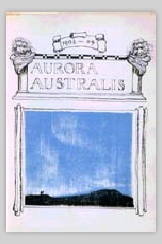
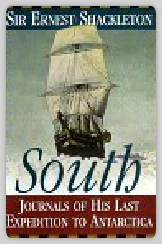
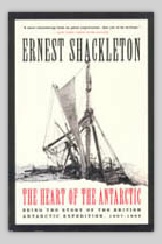
SKELTON, J.V. & WILSON, D.M.
Discovery Illustrated: Pictures From Captain Scott's First Antarctic Expedition
This book commemorating the centenary of the Discovery expedition. A limited edition of 200 copies with proceeds to support SPRI. Published 2001 by Reardon Publishing.
The Antarctic Journals of Reginald Skelton (Another little job for the Tinker)
by Judy Skelton.
With many pictures from Captain Scott's first Antarctic Expedition by Reginald Skelton who was Chief Engineer and Official Photographer to Captain Scott's Discovery Expedition.
The cheapest edition of this book is £60!
SMITH, Michael.
The Unsung Hero: Tom Crean
A key expedition member of many expeditions in the 'heroic age' at long last gets a biography. We read of many 'unsung hero's'. Tom Crean is one, for sure, another is Frank Wild...and of course Bowers... Campbell... Wilson, but then I am a little biased. Here we have a hard working, basically honest, sailor who is plucked from the ranks and rewards his superiors' by showing an extraordinary physical talent for polar travel. Crean was not a diary writer and this unfortunately shows in this book which at times seems to cover some old ground in order to pad out the story. Crean was a particular favourite of Scott's and I am still not sure why this was, even after reading his biography.
Published 2000 by Collins.
I Am Just Going Outside: Captain Oates- Antarctic Tragedy
Thankfully Oates was of an era where gentlemen wrote lengthy letters to their mothers and the British Army had battalions of record keepers. Our dear Titus has his background minutely scrutinised yet again- this time with some juicy bits of gossip. I note that Amazon have miss- titled this book calling it ' ........ Captain Scott's Antarctic Tragedy'. Yet strangely this slip has a unsettling truth about it. Scott made a mistake in taking Oates with him to the Pole (one of several) but thats why this subject matter is so interesting.
Published Spellmount 2002.
James Wordie Polar Crusader: Exploring the Artic and Antarctic
Michael Smith has the knack of picking the real heroes of Antarctic exploration and Wordie is no exception. James Wordie was a Scotsman who stayed on Elephant Island while Shackleton went cruising around the Southern Seas in an open boat. He was an extraordinary man and well deserves this study. I look forward to reading it.
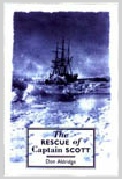
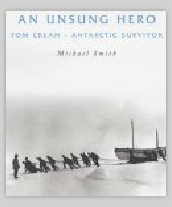
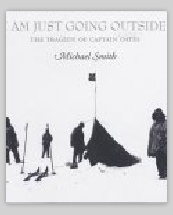
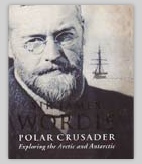
SMITH, Barnett G.
The Romance Of The South Pole
A wonderfully bound book with polar bears on the front cover! This is a precise of exploration up to the 1900's. It has some excellent half-tone illustrations and it is rare to come across a copy that has not been given as a prize at school or church. Published by Nelsons, my copy is undated but I suspect it was published in 1900.
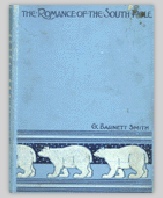
SOLOMAN, Susan.
The Coldest March: Scott's Fatal Antarctic Expedition
This is a book written by a senior scientist at the National Oceanic and Atmospheric Administration in Colorado. It gives a scientist view into reasons why Scott's return journey from the pole resulted in his death and of his companions. Scott is shown not to be the incompetent meddler as described in some other books, he was the victim of bad luck and some questionable decision making. The book is a scientist review of these decisions and makes for an interesting study. Published by Yale in 2001.
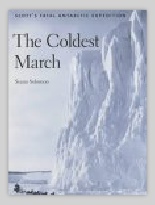
SPEAK, Peter.
WILLIAM SPEIRS BRUCE. POLAR EXPLORER AND SCOTTISH NATIONALIST
William Speirs Bruce, the polar naturalist and fervent Scottish nationalist, 'was a man who had more than a little of the stuff that heroes are made of, a man who did great things with a quiet will and a gentle heart, who rarely got that public recognition which was the due of his achievements'.
Born in London, Bruce elected to live and work in Scotland, immersing himself in the growing cultural renascence that ironically to distance him from influential London based scientific societies. Despite the unqualified success of the Scottish National Antarctic Expedition (1902-04) and his remarkable scientific work in polar regions, Bruce was destined to remain in the shadow of the more illustrious explorers of the 'Heroic Age', Scott and Shackleton, and his commitment to science over sensationalism served only to deny him his rightful place in polar history. This book aims to bring the name of William Spiers Bruce to the fore once again and to examine the nature of Scotland's forgotten hero.
Published by the National Museums of Scotland. £9.99
(This review from the books rear cover)
Deb: Geographer, Scientist, Antarctic Explorer. A biography of Frank Debenham
Frank Debenham - 'Deb' to all who knew him - was one of the youngest members of Scott's Terra Nova expedition of 1910-1913. Largely overlooked by history, he was nevertheless at the heart of that great adventure, during which he had his own life-threatening experiences. He was destined to go on to far greater things, for which he was awarded both the OBE and the Polar Medal, and to make his mark indelibly on Cambridge history. This thoroughly researched account is supported by illuminating extracts of correspondence, as well as numerous photographs and maps, some published here for the first time.
(Blurb from SPRI bookshop)
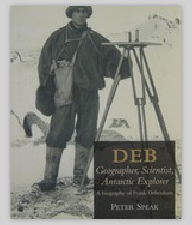
STEWART, John
Antarctica : An Encyclopaedia.
Useful resource with a list of expeditions from 1502 to 1990. Has a good bibliography section. Published in two vols. 1990 by McFarland.
SULLIVAN, Walker.
Quest For A Continent.
Quite a comprehensive book taking the reader from the first ice-age and the making of the Southern Continent to a chapter headed the Antarctic in the atomic age'. A strong USA bias. First published 1957 Secker & Wartburg.
